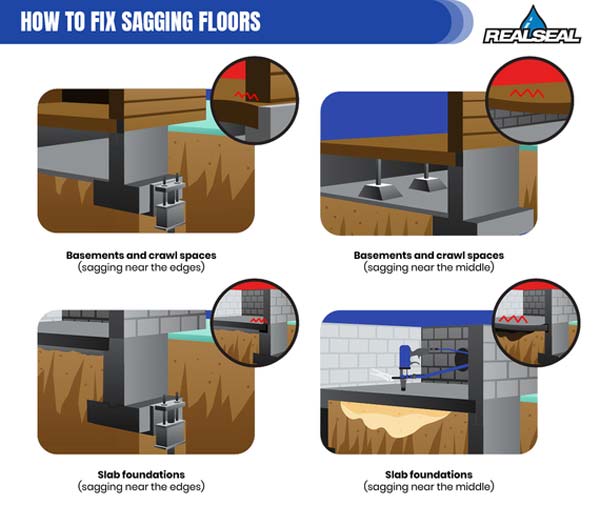Have you noticed an unwelcome dip in your flooring? Whether it’s caused by aging, moisture damage, or uneven support, a sagging floor can be both irritating and hazardous. Fortunately, with the right approach, you can restore your floor to its original level and stability.

Image: www.ncfoundationrepair.com
Crawl Space Inspection: The Root of the Problem
The first step in addressing a sagging floor is to determine the cause. For homes with accessible crawl spaces, a thorough inspection can shed light on the root of the problem. Look for signs of water damage, such as mold, mildew, or damp soil. If you notice any compromised joists or beams, it’s crucial to address the issue promptly to prevent further deterioration.
Joist and Beam Repair or Replacement
Depending on the extent of the joist damage, you may need to repair or replace the affected components. This process involves jacking up the floor to create enough space below to access the joists. If the joists are simply sagging, they can be reinforced with additional support, such as sister joists or steel plates. However, if they are severely damaged or compromised, replacing them is the recommended course of action.
Leveling the Sagging Floor
Once the joists are repaired or replaced, the next step is to level the sagging floor. This can be achieved by installing shims between the joists and the subfloor. Shims are thin, wedge-shaped pieces that elevate the subfloor to the desired level. It’s important to use shims of varying thicknesses to achieve a gradual and even elevation.
Expert Tip: To ensure proper leveling, use a laser level or a level placed on top of the subfloor to guide the installation of the shims. This will ensure a uniform and stable surface.

Image: viewfloor.co
Additional Support: Reinforcement and Insulation
In some cases, additional structural support may be necessary to strengthen the floor and prevent future sagging. This can involve installing sister joists, cross-bracing beams, or using steel beams or joist hangers. Additionally, consider adding insulation to the crawl space. This will help reduce moisture and temperature fluctuations, which can contribute to floor sagging.
Expert Advice for Long-Term Floor Stability
Proper Ventilation: Ensure adequate ventilation in the crawl space to prevent moisture accumulation. Install vents or moisture barriers to promote airflow and reduce humidity levels.
Regular Maintenance: Inspect the crawl space and floor periodically for any signs of damage or deterioration. Address minor issues promptly to prevent major problems.
FAQs on Sagging Floors
Q: What are the most common causes of sagging floors?
A: Aging, moisture damage, uneven support, and pests are typical causes.
Q: Can I fix a sagging floor without replacing the joists?
A: Yes, in some cases, you can repair the joists with sister joists or steel plates.
Q: How do I prevent floor sagging in the future?
A: Proper ventilation, regular maintenance, and avoiding overloading the floor can help.
How To Fix Sagging Floor In Crawl Space
Conclusion
Addressing a sagging floor requires a comprehensive approach that involves identifying the cause, repairing or replacing damaged components, leveling the floor, and adding structural support. By following the steps and tips outlined in this article, you can restore the stability of your floor and prevent further damage. If you’re not confident in tackling the project alone, consult a qualified flooring contractor for professional assistance.
Are you ready to take action and fix that sagging floor? Embrace the challenge and give your home a sturdy and level foundation!